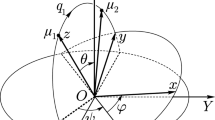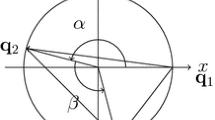In this section we provide the coefficients associated to the study of nonlinear stability for some cases and we also enunciate theorems that were used in the study of nonlinear stability of relative equilibria.
Coefficients Associated to the Study of Nonlinear Stability
Here we provide some coefficients associated to the study of nonlinear stability for the case of the right-angled RE, acute-angled isosceles RE and acute-angled RE.
Right-angled RE.
Constants \(h_{\mu_{1}\mu_{2}\nu_{1}\nu_{2}}\) associated to the polynomials \(H_{s}^{0}\) given in (6.1):
$$\displaystyle\begin{aligned} \hline\displaystyle h_{2010}&\displaystyle=-\dfrac{\sigma_{1}^{2}\sigma_{4}s_{2}f_{0120}}{2\sqrt{2}},&\displaystyle h_{2001}&\displaystyle=-\dfrac{\sigma_{1}^{2}\sigma_{2}s_{2}^{2}f_{0120}}{2\sqrt{2}s_{1}},&\displaystyle h_{1110}&\displaystyle=\dfrac{\sigma_{1}\sigma_{3}\sigma_{4}s_{1}f_{0120}}{\sqrt{2}},\\ \displaystyle h_{0210}&\displaystyle=-\dfrac{\sigma_{3}^{2}\sigma_{4}s_{1}^{2}f_{0120}}{2\sqrt{2}s_{2}},&\displaystyle h_{0201}&\displaystyle=-\dfrac{\sigma_{2}\sigma_{3}^{2}s_{1}f_{0120}}{2\sqrt{2}},&\displaystyle h_{0030}&\displaystyle=-\dfrac{\sigma_{4}\left(\sigma_{4}+1\right)}{\sqrt{2}s_{2}^{3}},\\ \displaystyle h_{0012}&\displaystyle=-\dfrac{\sigma_{2}^{2}-2\left(\sigma_{4}+1\right)\sigma_{2}+\sigma_{4}}{\sqrt{2}s_{1}^{2}s_{2}},&\displaystyle h_{0021}&\displaystyle=\dfrac{\sigma_{4}\left(\sigma_{4}+2\right)-\sigma_{2}\left(2\sigma_{4}+1\right)}{\sqrt{2}s_{1}s_{2}^{2}},&\displaystyle h_{0003}&\displaystyle=\dfrac{\left(\sigma_{2}-1\right)\sigma_{2}}{\sqrt{2}s_{1}^{3}},\\ \displaystyle h_{1101}&\displaystyle=\dfrac{\sigma_{1}\sigma_{2}\sigma_{3}s_{2}f_{0120}}{\sqrt{2}},\\ \hline\end{aligned}$$
$$\displaystyle\begin{array}[]{lllllll}h_{2020}=\dfrac{1}{4}\sigma_{1}^{2}\sigma_{4}\left(\sigma_{4}f_{0220}-f_{1120}\right),\quad h_{2002}=\dfrac{\sigma_{1}^{2}\sigma_{2}s_{2}^{2}\left(\sigma_{2}f_{0220}+f_{1120}\right)}{4s_{1}^{2}},&&&&&&\\ h_{1120}=\dfrac{\sigma_{1}\sigma_{3}\sigma_{4}s_{1}\left(f_{1120}-\sigma_{4}f_{0220}\right)}{2s_{2}},\quad h_{1102}=-\dfrac{\sigma_{1}\sigma_{2}\sigma_{3}s_{2}\left(\sigma_{2}f_{0220}+f_{1120}\right)}{2s_{1}},&&&&&&\\ h_{0220}=\dfrac{\sigma_{3}^{2}\sigma_{4}s_{1}^{2}\left(\sigma_{4}f_{0220}-f_{1120}\right)}{4s_{2}^{2}},\quad h_{0202}=\dfrac{1}{4}\sigma_{2}\sigma_{3}^{2}\left(\sigma_{2}f_{0220}+f_{1120}\right),&&&&&&\\ h_{0040}=\dfrac{\sigma_{4}\left(\sigma_{4}\left(\sigma_{4}\left(\sigma_{4}f_{0400}-f_{1300}\right)+f_{2200}\right)-f_{3100}\right)}{4s_{2}^{4}},&&&&&&\\ h_{0031}=\dfrac{\sigma_{4}\left(2\left(\sigma_{2}-\sigma_{4}\right)f_{2200}+\sigma_{4}\left(4\sigma_{2}\sigma_{4}f_{0400}+\left(\sigma_{4}-3\sigma_{2}\right)f_{1300}\right)\right)-\left(\sigma_{2}-3\sigma_{4}\right)f_{3100}}{4s_{1}s_{2}^{3}},&&&&&&\\ h_{0013}=\dfrac{\left(\sigma_{4}-3\sigma_{2}\right)f_{3100}+\sigma_{2}\left(\sigma_{2}\left(4\sigma_{2}\sigma_{4}f_{0400}-\left(\sigma_{2}-3\sigma_{4}\right)f_{1300}\right)-2\left(\sigma_{2}-\sigma_{4}\right)f_{2200}\right)}{4s_{1}^{3}s_{2}},&&&&&&\\ h_{0004}=\dfrac{\sigma_{2}\left(\sigma_{2}\left(\sigma_{2}\left(\sigma_{2}f_{0400}+f_{1300}\right)+f_{2200}\right)+f_{3100}\right)}{4s_{1}^{4}}.&&&&&&\\ \hline\end{array}$$
Constants \(\beta_{11}\), \(\beta_{12}\) and \(\beta_{22}\) associated to the polynomial \(H_{0}^{4}\) given in (6.2):
$$\displaystyle\begin{array}[]{rl}\beta_{11}=&\dfrac{\Omega_{1}-2\Omega_{2}}{16\Omega_{1}^{3}\Omega_{2}-4\Omega_{1}\Omega_{2}^{3}}\left(\left(8\Omega_{1}^{3}-3\Omega_{1}\Omega_{2}^{2}\right)h_{0012}^{2}-4\Omega_{1}^{2}\Omega_{2}h_{0210}h_{1101}+\left(8\Omega_{1}^{3}-3\Omega_{1}\Omega_{2}^{2}\right)\right.\\ &+h_{0210}^{2}+2\Omega_{1}h_{0012}\left(2\Omega_{1}\Omega_{2}h_{1101}+\left(8\Omega_{1}^{2}-\Omega_{2}^{2}\right)h_{0210}\right)+\Omega_{2}\left(15\left(\Omega_{2}^{2}-4\Omega_{1}^{2}\right)h_{0003}^{2}\right.\\ &\left.+6\left(\Omega_{2}^{2}-4\Omega_{1}^{2}\right)h_{0201}h_{0003}+3\left(\Omega_{2}^{2}-4\Omega_{1}^{2}\right)h_{0201}^{2}\right.\left.+\Omega_{1}\left(\Omega_{2}\left(-h_{1101}^{2}\right)\right.\right.,\\ &\left.\left.+6\left(4\Omega_{1}^{2}-\Omega_{2}^{2}\right)h_{0004}+\left(8\Omega_{1}^{2}-2\Omega_{2}^{2}\right)h_{0202}\right)\right),\\ \beta_{11}=&\dfrac{1}{4\Omega_{2}\Omega_{1}^{4}+8\Omega_{2}^{2}\Omega_{1}^{3}-\Omega_{2}^{3}\Omega_{1}^{2}-2\Omega_{2}^{4}\Omega_{1}}\left(4h_{\{0210\}}h_{\{2010\}}\Omega_{1}^{5}-12h_{\{0003\}}h_{\{0021\}}\Omega_{1}^{4}\Omega_{2}\right.\\ &-2h_{\{0210\}}^{2}\Omega_{2}\Omega_{1}^{4}-2h_{\{1101\}}^{2}\Omega_{2}\Omega_{1}^{4}-4h_{\{0021\}}h_{\{0201\}}\Omega_{2}\Omega_{1}^{4}+8h_{\{0021\}}h_{\{1110\}}\Omega_{2}\Omega_{1}^{4}\\ &-12h_{\{0003\}}h_{\{2001\}}\Omega_{2}\Omega_{1}^{4}-4h_{\{0201\}}h_{\{2001\}}\Omega_{2}\Omega_{1}^{4}-8h_{\{1110\}}h_{\{2001\}}\Omega_{2}\Omega_{1}^{4}\\ &4h_{\{0220\}}\Omega_{2}\Omega_{1}^{5}+4h_{\{2002\}}\Omega_{2}\Omega_{1}^{5}-8h_{\{0021\}}^{2}\Omega_{2}^{2}\Omega_{1}^{3}-2h_{\{0210\}}h_{\{1101\}}\Omega_{2}^{2}\Omega_{1}^{3}\\ &-8h_{\{1110\}}^{2}\Omega_{2}^{2}\Omega_{1}^{3}-8h_{\{2001\}}^{2}\Omega_{2}^{2}\Omega_{1}^{3}+16h_{\{0021\}}h_{\{2001\}}\Omega_{2}^{2}\Omega_{1}^{3}-17h_{\{0210\}}h_{\{2010\}}\Omega_{2}^{2}\Omega_{1}^{3}\\ &8h_{\{0210\}}^{2}\Omega_{1}^{2}\Omega_{2}^{3}+8h_{\{1101\}}^{2}\Omega_{1}^{2}\Omega_{2}^{3}+51h_{\{0003\}}h_{\{0021\}}\Omega_{1}^{2}\Omega_{2}^{3}+17h_{\{0021\}}h_{\{0201\}}\Omega_{1}^{2}\Omega_{2}^{3}\\ &-2h_{\{0021\}}h_{\{1110\}}\Omega_{1}^{2}\Omega_{2}^{3}+51h_{\{0003\}}h_{\{2001\}}\Omega_{1}^{2}\Omega_{2}^{3}+17h_{\{0201\}}h_{\{2001\}}\Omega_{1}^{2}\Omega_{2}^{3}\\ &2h_{\{0021\}}^{2}\Omega_{1}\Omega_{2}^{4}-17h_{\{0220\}}\Omega_{1}^{3}\Omega_{2}^{3}-17h_{\{2002\}}\Omega_{1}^{3}\Omega_{2}^{3}+2h_{\{1110\}}h_{\{2001\}}\Omega_{1}^{2}\Omega_{2}^{3}\\ &2h_{\{1110\}}^{2}\Omega_{1}\Omega_{2}^{4}+2h_{\{2001\}}^{2}\Omega_{1}\Omega_{2}^{4}+8h_{\{0210\}}h_{\{1101\}}\Omega_{1}\Omega_{2}^{4}-4h_{\{0021\}}h_{\{2001\}}\Omega_{1}\Omega_{2}^{4}\\ &-12h_{\{0003\}}h_{\{0021\}}\Omega_{2}^{5}-4h_{\{0021\}}h_{\{0201\}}\Omega_{2}^{5}+4h_{\{0210\}}h_{\{2010\}}\Omega_{1}\Omega_{2}^{4}\\ &-12h_{\{0003\}}h_{\{2001\}}\Omega_{2}^{5}-4h_{\{0201\}}h_{\{2001\}}\Omega_{2}^{5}+4h_{\{0220\}}\Omega_{1}\Omega_{2}^{5}+4h_{\{2002\}}\Omega_{1}\Omega_{2}^{5}\\ &\left(8\Omega_{1}^{2}\Omega_{2}^{3}-2\Omega_{1}^{4}\Omega_{2}\right)h_{\{0012\}}^{2}+3h_{\{0030\}}h_{\{0210\}}\Omega_{1}\left(4\Omega_{1}^{4}-17\Omega_{2}^{2}\Omega_{1}^{2}+4\Omega_{2}^{4}\right)\\ &h_{\{0012\}}\Omega_{1}\left(\Omega_{1}^{2}-4\Omega_{2}^{2}\right)\left(2\Omega_{2}\left(2h_{\{0210\}}\Omega_{1}+h_{\{1101\}}\Omega_{2}\right)+3h_{\{0030\}}\left(4\Omega_{1}^{2}-\Omega_{2}^{2}\right)\right.\\ &+\left.\left.h_{\{2010\}}\left(4\Omega_{1}^{2}-\Omega_{2}^{2}\right)\right)\right),\\ \beta_{22}=&\dfrac{1}{4\Omega_{1}\Omega_{2}\left(\Omega_{1}+2\Omega_{2}\right)}\left(3\Omega_{1}^{3}\left(5h_{0030}^{2}+2h_{2010}h_{0030}+h_{2010}^{2}\right)\right.+\Omega_{1}^{2}\left(-3h_{0021}^{2}-h_{1110}^{2}\right.\\ &-2h_{2001}h_{0021}-3h_{2001}^{2}\left.+2\Omega_{1}\left(3h_{0040}+h_{2020}\right)\right)\Omega_{2}-4\left(15h_{0030}^{2}+6h_{0030}h_{2010}\right.\\ &\left.+3h_{2010}^{2}+h_{1110}\left(h_{2001}-h_{0021}\right)\right)\Omega_{1}\Omega_{2}^{2}\left.+8\Omega_{2}^{3}\left(\left(h_{0021}+h_{2001}\right){}^{2}-\Omega_{1}\left(3h_{0040}+h_{2020}\right)\right)\right).\end{array}$$
Acute-angled isosceles RE. Constants \(f_{\mu_{1}\mu_{2}\nu_{1}\nu_{2}}\), associated to the polynomials \(H_{s}\) given in (6.3):
$$\displaystyle\begin{array}[]{ll}\hline f_{2100}=\dfrac{1}{16}(\cos(4\alpha_{0})+3)\csc^{2}\alpha_{0}\sec^{6}\alpha_{0},&\quad f_{1200}=-\dfrac{1}{16}(\cos(4\alpha_{0})+3)\csc^{2}\alpha_{0}\sec^{6}\alpha_{0},\\
f_{0300}=-2\sin^{2}\alpha_{0}\sin(4\alpha_{0})\csc^{7}(2\alpha_{0}),&\quad f_{0120}=\dfrac{1}{4}\cot\alpha_{0}\csc^{2}\alpha_{0},\\\hline \end{array}$$
$$\displaystyle\begin{array}[]{ll}f_{4000}=\dfrac{1}{12}\cos(2\alpha_{0})\csc\alpha_{0}\sec^{5}\alpha_{0},&f_{2200}=-\dfrac{1}{32}\cos(2\alpha_{0})(\cos(4\alpha_{0})+5)\csc^{3}\alpha_{0}\sec^{7}\alpha_{0},\\
f_{3100}=-\dfrac{1}{6}\cos(2\alpha_{0})\csc\alpha_{0}\sec^{5}\alpha_{0},&f_{1300}=\dfrac{1}{48}\cos(2\alpha_{0})(\cos(4\alpha_{0})+8)\csc^{3}\alpha_{0}\sec^{7}\alpha_{0},\\
f_{1120}=-\cot(2\alpha_{0})\csc(2\alpha_{0}),&f_{0400}=\dfrac{1}{384}(7\cos(4\alpha_{0})+11)\csc^{5}\alpha_{0}\sec^{7}\alpha_{0},\\
f_{2020}=\cot(2\alpha_{0})\csc(2\alpha_{0}),&f_{0220}=-\dfrac{1}{32}(2\cos(2\alpha_{0})+\cos(4\alpha_{0})+3)\csc^{4}\alpha_{0}\sec^{2}\alpha_{0},\\ \hline\end{array}$$
$$\displaystyle\begin{array}[]{ll}f_{4100}=-\dfrac{1}{48}(\cos(4\alpha_{0})+3)\csc^{2}\alpha_{0}\sec^{6}\alpha_{0},&\quad f_{3200}=\dfrac{1}{24}(\cos(4\alpha_{0})+3)\csc^{2}\alpha_{0}\sec^{6}\alpha_{0},\\
f_{2120}=-\dfrac{1}{2}(\cos(4\alpha_{0})+3)\csc^{3}(2\alpha_{0}),&\quad f_{1220}=\left(2\cot^{2}(2\alpha_{0})+1\right)\csc(2\alpha_{0}),\end{array}$$
$$\displaystyle\begin{array}[]{l}f_{2300}=\dfrac{1}{384}(22\cos(4\alpha_{0})+\cos(8\alpha_{0})+25)\csc^{4}\alpha_{0}\sec^{8}\alpha_{0},\\
f_{1400}=-\dfrac{1}{768}(40\cos(4\alpha_{0})+\cos(8\alpha_{0})+55)\csc^{4}\alpha_{0}\sec^{8}\alpha_{0},\\
f_{0500}=-\dfrac{1}{256}(7\cos(2\alpha_{0})+\cos(6\alpha_{0}))\csc^{6}\alpha_{0}\sec^{8}\alpha_{0},\\
f_{0320}=\dfrac{1}{192}(17\cos(2\alpha_{0})+2\cos(4\alpha_{0})+\cos(6\alpha_{0})+4)\csc^{5}\alpha_{0}\sec^{3}\alpha_{0},\\\hline\end{array}$$
$$\displaystyle\begin{array}[]{ll}f_{6000}=-\dfrac{1}{90}\cos(2\alpha_{0})\csc\alpha_{0}\sec^{5}\alpha_{0},&f_{4200}=\dfrac{1}{96}\cos(2\alpha_{0})(\cos(4\alpha_{0})+5)\csc^{3}\alpha_{0}\sec^{7}\alpha_{0},\\
f_{5100}=\dfrac{1}{30}\cos(2\alpha_{0})\csc\alpha_{0}\sec^{5}\alpha_{0},&f_{3300}=-\dfrac{1}{72}\cos(2\alpha_{0})(\cos(4\alpha_{0})+8)\csc^{3}\alpha_{0}\sec^{7}\alpha_{0},\\
f_{4020}=-\dfrac{1}{3}\cot(2\alpha_{0})\csc(2\alpha_{0}),&f_{3120}=\dfrac{2}{3}\cot(2\alpha_{0})\csc(2\alpha_{0}),\end{array}$$
$$\displaystyle\begin{array}[]{l}f_{2400}=-\dfrac{1}{1536}\cos(2\alpha_{0})(44\cos(4\alpha_{0})+\cos(8\alpha_{0})+75)\csc^{5}\alpha_{0}\sec^{9}\alpha_{0},\\
f_{2220}=\cot(2\alpha_{0})\left(3\cot^{2}(2\alpha_{0})+2\right)\csc(2\alpha_{0}),\\
f_{1500}=\dfrac{1}{3840}\cos(2\alpha_{0})(86\cos(4\alpha_{0})+\cos(8\alpha_{0})+213)\csc^{5}\alpha_{0}\sec^{9}\alpha_{0},\\
f_{1320}=-\dfrac{1}{3}(\cos(4\alpha_{0})+8)\cot(2\alpha_{0})\csc^{3}(2\alpha_{0}),\\
f_{0600}=\dfrac{1}{46080}(416\cos(4\alpha_{0})+31\cos(8\alpha_{0})+453)\csc^{7}\alpha_{0}\sec^{9}\alpha_{0},\\
f_{0420}=-\dfrac{1}{1536}(22\cos(2\alpha_{0})+40\cos(4\alpha_{0})+2\cos(6\alpha_{0})+\cos(8\alpha_{0})+55)\csc^{6}\alpha_{0}\sec^{4}\alpha_{0}.\\\hline\end{array}$$
Acute-angled RE. Constants \(f_{\mu_{1}\mu_{2}\nu_{1}\nu_{2}}\), associated to the polynomials \(H_{3}\) and \(H_{4}\) given in (6.5):
$$\displaystyle\begin{array}[]{l}\hline f_{0300}=-\dfrac{(\mu+1)\cos\alpha_{0}\cot q_{0}\csc^{3}q_{0}}{\mu\cos\alpha_{0}\cos q_{0}+\cos(q_{0}-\alpha_{0})},\quad f_{2100}=\dfrac{\sec\alpha_{0}\csc q_{0}(\sin(2\alpha_{0})+(\mu+1)\cos(2\alpha_{0})\cot q_{0})}{\mu\cos\alpha_{0}\cos q_{0}+\cos(q_{0}-\alpha_{0})},\end{array}$$
$$\displaystyle\begin{array}[]{l}f_{0120}=\cos\alpha_{0}\csc^{2}q_{0}(\sin\alpha_{0}+(\mu+1)\cos\alpha_{0}\cot q_{0}),\\ f_{1200}=\dfrac{\cos(2\alpha_{0})\sec\alpha_{0}\cot q_{0}\csc q_{0}-(\mu+1)\sin\alpha_{0}(\cos(2q_{0})+2)\csc^{3}q_{0}}{\mu\cos\alpha_{0}\cos q_{0}+\cos(q_{0}-\alpha_{0})},\\\hline\end{array}$$
$$\displaystyle f_{4000}=\dfrac{\sec\alpha_{0}\csc q_{0}(\mu\cos(2\alpha_{0})+\cos(2(q_{0}-\alpha_{0})))}{6(\mu\cos\alpha_{0}\cos q_{0}+\cos(q_{0}-\alpha_{0}))},$$
$$\displaystyle f_{3100}=\dfrac{2\csc q_{0}(\cos\alpha_{0}-\sin\alpha_{0}(\tan\alpha_{0}+2(\mu+1)\cot q_{0}))}{3(\mu\cos\alpha_{0}\cos q_{0}+\cos(q_{0}-\alpha_{0}))},$$
$$\displaystyle f_{2020}=\dfrac{1}{2}\csc^{2}q_{0}(\mu\cos(2\alpha_{0})+\cos(2(q_{0}-\alpha_{0}))),$$
$$\displaystyle f_{1120}=\csc^{2}q_{0}(\cos(2\alpha_{0})-(\mu+1)\sin(2\alpha_{0})\cot q_{0}),$$
$$\displaystyle f_{2200}=-\dfrac{2(\mu+1)\cos(2\alpha_{0})\sec\alpha_{0}(\cos(2q_{0})+2)\csc^{3}q_{0}+8\sin\alpha_{0}\cot q_{0}\csc q_{0}}{4(\mu\cos\alpha_{0}\cos q_{0}+\cos(q_{0}-\alpha_{0}))},$$
$$\displaystyle f_{1300}=\dfrac{\csc^{3}q_{0}(2(\mu+1)\sin\alpha_{0}(\cos(2q_{0})+5)\cot q_{0}-\cos(2\alpha_{0})\sec\alpha_{0}(\cos(2q_{0})+2))}{3(\mu\cos\alpha_{0}\cos q_{0}+\cos(q_{0}-\alpha_{0}))},$$
$$\displaystyle f_{0400}=\dfrac{(\mu+1)\cos\alpha_{0}(7\cos(2q_{0})+11)\csc^{5}q_{0}}{12(\mu\cos\alpha_{0}\cos q_{0}+\cos(q_{0}-\alpha_{0}))},$$
$$\displaystyle f_{0220}=-\dfrac{1}{4}\cos\alpha_{0}\csc^{4}q_{0}(2(\mu+1)\cos\alpha_{0}(\cos(2q_{0})+2)+2\sin\alpha_{0}\sin(2q_{0})).$$
Constants \(h_{\mu_{1}\mu_{2}\nu_{1}\nu_{2}}\) associated to the polynomials \(H_{3}^{0}\) and \(H_{4}^{0}\) given in (6.6).
$$\displaystyle\begin{array}[]{l}\hline\begin{array}[]{lll}h_{2010}=8\gamma^{3}s_{2}^{2}\xi\Omega_{2}f_{0120},&h_{2001}=-8\gamma^{2}\delta s_{2}^{2}\xi\Omega_{1}f_{0120},&h_{1110}=16\gamma^{2}\delta\sigma_{2}s_{2}\xi\Omega_{2}f_{0120},\\ h_{1101}=-16\gamma\delta^{2}\sigma_{2}s_{2}\xi\Omega_{1}f_{0120},&h_{0210}=8\gamma\delta^{2}\sigma_{2}^{2}\xi\Omega_{2}f_{0120},&h_{0201}=-8\delta^{3}\sigma_{2}^{2}\xi\Omega_{1}f_{0120},\end{array}\\ \begin{array}[]{l}h_{0030}=2\gamma^{3}\xi\Omega_{2}^{3}\left(s_{1}\left(s_{1}f_{2100}+2\xi f_{1200}\right)+4\xi^{2}f_{0300}\right),\\ h_{0021}=-2\gamma^{2}\delta\xi\Omega_{1}\Omega_{2}^{2}\left(2\xi\left((\sigma_{1}+2s_{1})f_{1200}+6\xi f_{0300}\right)+s_{1}(2\sigma_{1}+s_{1})f_{2100}\right),\\ h_{0012}=2\gamma\delta^{2}\xi\Omega_{1}^{2}\Omega_{2}\left(2\xi\left((2\sigma_{1}+s_{1})f_{1200}+6\xi f_{0300}\right)+\sigma_{1}(\sigma_{1}+2s_{1})f_{2100}\right),\\ h_{0003}=-2\delta^{3}\xi\Omega_{1}^{3}\left(\sigma_{1}\left(\sigma_{1}f_{2100}+2\xi f_{1200}\right)+4\xi^{2}f_{0300}\right),\end{array}\\ \hline\begin{array}[]{rl}h_{2020}=&4s_{2}^{2}\gamma^{4}\left(4f_{0220}\xi^{2}+s_{1}\left(2\xi f_{1120}+s_{1}f_{2020}\right)\right)\Omega_{2}^{2},\\ h_{2011}=&-8s_{2}^{2}\gamma^{3}\delta\left(4f_{0220}\xi^{2}+(\sigma_{1}+s_{1})f_{1120}\xi+\sigma_{1}s_{1}f_{2020}\right)\Omega_{1}\Omega_{2},\\ h_{2002}=&4s_{2}^{2}\gamma^{2}\delta^{2}\left(4f_{0220}\xi^{2}+\sigma_{1}\left(2\xi f_{1120}+\sigma_{1}f_{2020}\right)\right)\Omega_{1}^{2},\\ h_{1120}=&8\sigma_{2}s_{2}\gamma^{3}\delta\left(4f_{0220}\xi^{2}+s_{1}\left(2\xi f_{1120}+s_{1}f_{2020}\right)\right)\Omega_{2}^{2},\\ h_{1111}=&-16\sigma_{2}s_{2}\gamma^{2}\delta^{2}\left(4f_{0220}\xi^{2}+(\sigma_{1}+s_{1})f_{1120}\xi+\sigma_{1}s_{1}f_{2020}\right)\Omega_{1}\Omega_{2},\\ h_{1102}=&8\sigma_{2}s_{2}\gamma\delta^{3}\left(4f_{0220}\xi^{2}+\sigma_{1}\left(2\xi f_{1120}+\sigma_{1}f_{2020}\right)\right)\Omega_{1}^{2},\\ h_{0220}=&4\sigma_{2}^{2}\gamma^{2}\delta^{2}\left(4f_{0220}\xi^{2}+s_{1}\left(2\xi f_{1120}+s_{1}f_{2020}\right)\right)\Omega_{2}^{2},\\ h_{0211}=&-8\sigma_{2}^{2}\gamma\delta^{3}\left(4f_{0220}\xi^{2}+(\sigma_{1}+s_{1})f_{1120}\xi+\sigma_{1}s_{1}f_{2020}\right)\Omega_{1}\Omega_{2},\\ h_{0202}=&4\sigma_{2}^{2}\delta^{4}\left(4f_{0220}\xi^{2}+\sigma_{1}\left(2\xi f_{1120}+\sigma_{1}f_{2020}\right)\right)\Omega_{1}^{2},\\ h_{0040}=&\gamma^{4}\left(16f_{0400}\xi^{4}+s_{1}\left(8f_{1300}\xi^{3}+s_{1}\left(f_{4000}s_{1}^{2}+2\xi f_{3100}s_{1}+4\xi^{2}f_{2200}\right)\right)\right)\Omega_{2}^{4},\\ h_{0031}=&-2\gamma^{3}\delta\left(32f_{0400}\xi^{4}+4(\sigma_{1}+3s_{1})f_{1300}\xi^{3}+s_{1}\left(4(\sigma_{1}+s_{1})f_{2200}\xi^{2}\right.\right.\\ &\left.\left.+s_{1}\left((3\sigma_{1}+s_{1})\xi f_{3100}+2\sigma_{1}s_{1}f_{4000}\right)\right)\right)\Omega_{1}\Omega_{2}^{3},\\ h_{0022}=&2\gamma^{2}\delta^{2}\left(48f_{0400}\xi^{4}+12(\sigma_{1}+s_{1})f_{1300}\xi^{3}+2\sigma_{1}^{2}f_{2200}\xi^{2}+2s_{1}^{2}f_{2200}\xi^{2}+8\sigma_{1}s_{1}f_{2200}\xi^{2}\right.\\ &\left.+3\sigma_{1}s_{1}^{2}f_{3100}\xi+3\sigma_{1}^{2}s_{1}f_{3100}\xi+3\sigma_{1}^{2}s_{1}^{2}f_{4000}\right)\Omega_{1}^{2}\Omega_{2}^{2},\\ h_{0013}=&-2\gamma\delta^{3}\left(32f_{0400}\xi^{4}+4(3\sigma_{1}+s_{1})f_{1300}\xi^{3}+\sigma_{1}\left(4(\sigma_{1}+s_{1})f_{2200}\xi^{2}\right.\right.\\ &\left.\left.+\sigma_{1}\left((\sigma_{1}+3s_{1})\xi f_{3100}+2\sigma_{1}s_{1}f_{4000}\right)\right)\right)\Omega_{1}^{3}\Omega_{2},\\ h_{0004}=&\delta^{4}\left(16f_{0400}\xi^{4}+\sigma_{1}\left(8f_{1300}\xi^{3}+r_{1}\left(f_{4000}r_{1}^{2}+2tf_{3100}r_{1}+4\xi^{2}f_{2200}\right)\right)\right)\Omega_{1}^{4}.\end{array}\\ \hline\end{array}$$
Constants associated to the polynomials in the normal form \(H_{0}^{4}\) given in (6.7):
$$\displaystyle\begin{array}[]{rl}\beta_{11}=&\left.60h_{0030}^{2}\Omega_{1}^{5}+12h_{2010}^{2}\Omega_{1}^{5}+24h_{0030}h_{2010}\Omega_{1}^{5}+24h_{0040}\Omega_{2}\Omega_{1}^{5}+8h_{2020}\Omega_{2}\Omega_{1}^{5}-12h_{2001}^{2}\Omega_{2}\Omega_{1}^{4}\right.\\ &-8h_{0021}h_{2001}\Omega_{2}\Omega_{1}^{4}-255h_{0030}^{2}\Omega_{2}^{2}\Omega_{1}^{3}-51h_{2010}^{2}\Omega_{2}^{2}\Omega_{1}^{3}+16h_{0021}h_{1110}\Omega_{2}^{2}\Omega_{1}^{3}\\ &-102h_{0030}h_{2010}\Omega_{2}^{2}\Omega_{1}^{3}-102h_{0040}\Omega_{1}^{3}\Omega_{2}^{3}+35h_{0021}^{2}\Omega_{1}^{2}\Omega_{2}^{3}+h_{1110}^{2}\Omega_{1}^{2}\Omega_{2}^{3}+35h_{2001}^{2}\Omega_{1}^{2}\Omega_{2}^{3}\\ &+66h_{0021}h_{2001}\Omega_{1}^{2}\Omega_{2}^{3}+60h_{0030}^{2}\Omega_{1}\Omega_{2}^{4}-4h_{0021}h_{1110}\Omega_{1}\Omega_{2}^{4}+4h_{1110}h_{2001}\Omega_{1}\Omega_{2}^{4}\\ &-8h_{0021}^{2}\Omega_{2}^{5}-16h_{0021}h_{2001}\Omega_{2}^{5}+12h_{2010}^{2}\Omega_{1}\Omega_{2}^{4}+24h_{0030}h_{2010}\Omega_{1}\Omega_{2}^{4}-16h_{1110}h_{2001}\Omega_{2}^{2}\Omega_{1}^{3}\\ &\left.-8h_{2001}^{2}\Omega_{2}^{5}+24h_{0040}\Omega_{1}\Omega_{2}^{5}+8h_{2020}\Omega_{1}\Omega_{2}^{5}-12h_{0021}^{2}\Omega_{2}\Omega_{1}^{4}-4h_{1110}^{2}\Omega_{2}\Omega_{1}^{4}-34h_{2020}\Omega_{1}^{3}\Omega_{2}^{3},\right.\end{array}$$
$$\displaystyle\begin{array}[]{rl}\beta_{12}=&8h_{0012}h_{0030}\Omega_{1}^{5}+48h_{0030}h_{0210}\Omega_{1}^{5}+16h_{0012}h_{2010}\Omega_{1}^{5}+16h_{0210}h_{2010}\Omega_{1}^{5}-8h_{0012}^{2}\Omega_{2}\Omega_{1}^{4}\\ &-48h_{0003}h_{0021}\Omega_{2}\Omega_{1}^{4}-16h_{0021}h_{0201}\Omega_{2}\Omega_{1}^{4}-8h_{0210}^{2}\Omega_{2}\Omega_{1}^{4}-8h_{1101}^{2}\Omega_{2}\Omega_{1}^{4}+16h_{0022}\Omega_{2}\Omega_{1}^{5}\\ &+32h_{0021}h_{1110}\Omega_{2}\Omega_{1}^{4}+16h_{0220}\Omega_{2}\Omega_{1}^{5}-16h_{0201}h_{2001}\Omega_{2}\Omega_{1}^{4}16h_{2002}\Omega_{2}\Omega_{1}^{5}-32h_{0021}^{2}\Omega_{2}^{2}\Omega_{1}^{3}\\ &-204h_{0012}h_{0030}\Omega_{2}^{2}\Omega_{1}^{3}-32h_{2001}^{2}\Omega_{2}^{2}\Omega_{1}^{3}-68h_{0012}h_{2010}\Omega_{2}^{2}\Omega_{1}^{3}-68h_{0210}h_{2010}\Omega_{2}^{2}\Omega_{1}^{3}\\ &-32h_{1110}^{2}\Omega_{2}^{2}\Omega_{1}^{3}+8h_{0012}h_{1101}\Omega_{2}^{2}\Omega_{1}^{3}-8h_{0210}h_{1101}\Omega_{2}^{2}\Omega_{1}^{3}+64h_{0021}h_{2001}\Omega_{2}^{2}\Omega_{1}^{3}\\ &+32h_{0210}^{2}\Omega_{1}^{2}\Omega_{2}^{3}+204h_{0003}h_{0021}\Omega_{1}^{2}\Omega_{2}^{3}+68h_{0021}h_{0201}\Omega_{1}^{2}\Omega_{2}^{3}-64h_{0012}h_{0210}\Omega_{1}^{2}\Omega_{2}^{3}\\ &+32h_{1101}^{2}\Omega_{1}^{2}\Omega_{2}^{3}-8h_{0021}h_{1110}\Omega_{1}^{2}\Omega_{2}^{3}+204h_{0003}h_{2001}\Omega_{1}^{2}\Omega_{2}^{3}+68h_{0201}h_{2001}\Omega_{1}^{2}\Omega_{2}^{3}\\ &+8h_{0021}^{2}\Omega_{1}\Omega_{2}^{4}-68h_{0022}\Omega_{1}^{3}\Omega_{2}^{3}-68h_{0220}\Omega_{1}^{3}\Omega_{2}^{3}-68h_{2002}\Omega_{1}^{3}\Omega_{2}^{3}+8h_{1110}h_{2001}\Omega_{1}^{2}\Omega_{2}^{3}\\ &+48h_{0012}h_{0030}\Omega_{1}\Omega_{2}^{4}+48h_{0030}h_{0210}\Omega_{1}\Omega_{2}^{4}-32h_{0012}h_{1101}\Omega_{1}\Omega_{2}^{4}-48h_{0003}h_{2001}\Omega_{2}\Omega_{1}^{4}\\ &+8h_{1110}^{2}\Omega_{1}\Omega_{2}^{4}+8h_{2001}^{2}\Omega_{1}\Omega_{2}^{4}+32h_{0210}h_{1101}\Omega_{1}\Omega_{2}^{4}-16h_{0021}h_{2001}\Omega_{1}\Omega_{2}^{4}+32h_{0012}^{2}\Omega_{2}^{3}\Omega_{1}^{2}\\ &-48h_{0003}h_{0021}\Omega_{2}^{5}+16h_{0012}h_{2010}\Omega_{1}\Omega_{2}^{4}+16h_{0210}h_{2010}\Omega_{1}\Omega_{2}^{4}-204h_{0030}h_{0210}\Omega_{2}^{2}\Omega_{1}^{3}\\ &-16h_{0021}h_{0201}\Omega_{2}^{5}-48h_{0003}h_{2001}\Omega_{2}^{5}-16h_{0201}h_{2001}\Omega_{2}^{5}+16h_{0022}\Omega_{1}\Omega_{2}^{5}+16h_{0220}\Omega_{1}\Omega_{2}^{5}\\ &+16h_{0012}h_{0210}\Omega_{2}\Omega_{1}^{4}+16h_{2002}\Omega_{1}\Omega_{2}^{5}-32h_{1110}h_{2001}\Omega_{2}\Omega_{1}^{4},\end{array}$$
$$\displaystyle\begin{array}[]{rl}\beta_{22}=&8h_{0012}^{2}\Omega_{1}^{5}+8h_{0210}^{2}\Omega_{1}^{5}+16h_{0012}h_{0210}\Omega_{1}^{5}-60h_{0003}^{2}\Omega_{2}\Omega_{1}^{4}-12h_{0201}^{2}\Omega_{2}\Omega_{1}^{4}\\ &24h_{0004}\Omega_{2}\Omega_{1}^{5}+8h_{0202}\Omega_{2}\Omega_{1}^{5}+4h_{0012}h_{1101}\Omega_{2}\Omega_{1}^{4}-4h_{0210}h_{1101}\Omega_{2}\Omega_{1}^{4}-35h_{0012}^{2}\Omega_{2}^{2}\Omega_{1}^{3}\\ &-35h_{0210}^{2}\Omega_{2}^{2}\Omega_{1}^{3}-h_{1101}^{2}\Omega_{2}^{2}\Omega_{1}^{3}+255h_{0003}^{2}\Omega_{2}^{3}\Omega_{1}^{2}+51h_{0201}^{2}\Omega_{2}^{3}\Omega_{1}^{2}+102h_{0003}h_{0201}\Omega_{2}^{3}\Omega_{1}^{2}\\ &12h_{0012}^{2}\Omega_{1}\Omega_{2}^{4}+12h_{0210}^{2}\Omega_{1}\Omega_{2}^{4}+8h_{0012}h_{0210}\Omega_{1}\Omega_{2}^{4}-102h_{0004}\Omega_{1}^{3}\Omega_{2}^{3}-34h_{0202}\Omega_{1}^{3}\Omega_{2}^{3}\\ &-60h_{0003}^{2}\Omega_{2}^{5}-12h_{0201}^{2}\Omega_{2}^{5}-24h_{0003}h_{0201}\Omega_{2}^{5}+24h_{0004}\Omega_{1}\Omega_{2}^{5}+8h_{0202}\Omega_{1}\Omega_{2}^{5}+4h_{1101}^{2}\Omega_{1}\Omega_{2}^{4}\\ &-24h_{0003}h_{0201}\Omega_{2}\Omega_{1}^{4}-66h_{0012}h_{0210}\Omega_{2}^{2}\Omega_{1}^{3}+16h_{0210}h_{1101}\Omega_{1}^{2}\Omega_{2}^{3}-16h_{0012}h_{1101}\Omega_{2}^{3}\Omega_{1}^{2}.\\ \end{array}$$
Constants associated to the polynomials in the normal form \(H_{0}^{4}\) given in (6.8):
$$\displaystyle\xi_{11}=\dfrac{1}{60\Omega_{2}}\left(-19h_{0021}^{2}+12h_{1110}h_{0021}-2h_{2001}h_{0021}+225h_{0030}^{2}-9h_{1110}^{2}\right.$$
$$\displaystyle\quad\left.-19h_{2001}^{2}-12h_{1110}h_{2001}+45h_{2010}^{2}+90h_{0030}h_{2010}+90h_{0040}\Omega_{2}+30h_{2020}\Omega_{2}\right)$$
$$\displaystyle\xi_{12}=\dfrac{1}{420\Omega_{2}}\left(-72h_{0012}^{2}+1260h_{0030}h_{0012}-168h_{0021}^{2}-420h_{0003}h_{0021}-140h_{0021}h_{0201}\right.$$
$$\displaystyle\quad\left.-72h_{0210}^{2}+144h_{0012}h_{0210}+1260h_{0030}h_{0210}-24h_{1101}h_{0210}+24h_{0012}h_{1101}\right.$$
$$\displaystyle\quad\left.-72h_{1101}^{2}-168h_{1110}^{2}+504h_{0021}h_{1110}-420h_{0003}h_{2001}+336h_{0021}h_{2001}\right.$$
$$\displaystyle\quad\left.-168h_{2001}^{2}-140h_{0201}h_{2001}-504h_{1110}h_{2001}+420h_{0012}h_{2010}+420h_{0210}h_{2010}\right.$$
$$\displaystyle\quad\left.420h_{0022}\Omega_{2}+420h_{0220}\Omega_{2}+420h_{2002}\Omega_{2}\right)$$
$$\displaystyle\xi_{22}=\dfrac{1}{140\Omega_{2}}\left(-175h_{0003}^{2}-70h_{0201}h_{0003}+69h_{0012}^{2}-35h_{0201}^{2}+69h_{0210}^{2}+142h_{0012}h_{0210}\right.$$
$$\displaystyle\quad\left.-h_{1101}^{2}+12h_{0012}h_{1101}-12h_{0210}h_{1101}+210h_{0004}\Omega_{2}+70h_{0202}\Omega_{2}\right)$$
$$\displaystyle B=\dfrac{1}{420\Omega_{2}}\left(-252h_{0,0,1,2}h_{0,0,2,1}-420h_{0,0,3,0}h_{0,0,2,1}-168h_{0,2,1,0}h_{0,0,2,1}+42h_{1,1,0,1}h_{0,0,2,1}\right.$$
$$\displaystyle\quad\left.168h_{0,0,1,2}h_{1,1,1,0}+630h_{0,0,3,0}h_{1,1,1,0}+252h_{0,2,1,0}h_{1,1,1,0}+42h_{1,1,0,1}h_{1,1,1,0}\right.$$
$$\displaystyle\quad\left.252h_{0,0,1,2}h_{2,0,0,1}+840h_{0,0,3,0}h_{2,0,0,1}+168h_{0,2,1,0}h_{2,0,0,1}-42h_{1,1,0,1}h_{2,0,0,1}\right.$$
$$\displaystyle\quad\left.-420h_{0,0,2,1}h_{2,0,1,0}+210h_{1,1,1,0}h_{2,0,1,0}+210h_{0,0,3,1}\Omega_{2}-210h_{1,1,2,0}\Omega_{2}-210h_{2,0,1,1}\Omega_{2}\right)$$
Results about Stability
Let us suppose that the frequencies \(\omega_{1}\) and \(\omega_{2}\) satisfy the resonance relation \(a\omega_{1}-b\omega_{1}=0\), where \(a\) and \(b\) are relatively prime positive integers or \(a=b=1\). If \(a=b=1\), we will suppose that the matrix associated to the linear system is diagonalizable. In addition, we assume that the Hamiltonian is written in action-angle variables \((I,\varphi)=(I_{1},I_{2},\varphi_{1},\varphi_{2})\), being in its normal form up to order \(m=2l-1\) or \(m=2l\), i. e.,
$$H(I,\varphi)=H_{2}(I)+\cdots+H_{2l-2}(I)+H_{m}(I,a\varphi_{1}+b\varphi_{2})+H^{*},$$
(A.1)
where
-
\(H_{2}=\omega_{1}I_{1}-\omega_{2}I_{2}\);
-
\(H_{2j}\) is a homogeneous polynomial of degree \(j\) in \(I_{1}\) and \(I_{2}\);
-
\(H_{m}(I,a\varphi_{1}+b\varphi_{2})\) is a homogeneous polynomial of degree \(m\) in \(\sqrt{I_{1}},\sqrt{I_{2}}\) with coefficients that possess finite Fourier series in a unique angle \(a\varphi_{1}+b\varphi_{2}\);
-
\(H^{*}\) denotes terms of order greater than \(m\) in the variables \(\sqrt{I_{1}}\) and \(\sqrt{I_{2}}\);
-
\(H\) is an analytical function in the variables \(\sqrt{I_{1}},\sqrt{I_{2}},\varphi_{1},\varphi_{2}\) and \(2\pi\)-periodic in \(\varphi_{1}\) and \(\varphi_{2}\).
Consider the function
$$\Psi(\phi)=H_{m}(\omega_{2},\omega_{1},a\phi),$$
(A.2)
where \(\phi=\varphi_{1}+\frac{b}{a}\varphi_{2}\) and define \(D_{2j}=H_{2j}(\omega_{2},\omega_{1})\).
Theorem 11
(Arnold’s Theorem)
If there exists some
\(j=2,\cdots,l-1\)
, with
\(D_{2j}\neq 0\)
, then the equilibrium solution
\(q_{i}=p_{i}=0\)
of
(A.1)
is stable in the sense of Lyapunov.
See the original proof in [2, 14] and also [13].
In the case where \(D_{2j}=0\), for \(j=2,\cdots,l-1\), we have the following result.
Theorem 12
(Sokol’skii – Cabral – Meyer’s Theorem)
If
\(\Psi(\phi)\neq 0\)
, for all
\(\phi\)
, then the equilibrium point
\(q_{i}=p_{i}=0\)
of
(A.1)
is stable in the sense of Lyapunov, while, if
\(\Psi(\phi)\neq 0\)
has a simple zero, then the equilibrium point
\(q_{i}=p_{i}=0\)
of
(A.1)
is unstable in the sense of Lyapunov.
See the proof in Theorem 4.1 in [6] or a particular version for resonances of order \(2\) in Theorem 2.1 in [16], resonances of order \(3\) and \(4\) in Theorems 2.1 and 3.1 in [11].
Now let us suppose that the Hamiltonian is in Cartesian coordinates \((X,Y,P_{1},P_{2})\) and has the form
$$H=\frac{\delta_{1}}{2}Y^{2}+\frac{\delta_{2}\omega}{2}(X+P_{1}^{2})+H^{3}+H^{4}+\cdots,$$
(A.3)
where
$$H^{s}=h_{0s00}P_{2}^{s}+\sum_{j=1}h_{0s-2jj}P_{2}^{2-2j}(X^{2}+P_{1}^{2})^{j},\quad\mbox{for }s=3,4,\cdots$$
Let
\(M\) be the lowest positive integer such that
\(h_{0M00}\neq 0\). Then we have the following result related to the Lyapunov stability.
Theorem 13
(Sokol’skii, 1978)
If
\(M\)
is odd, then the equilibrium
\((0,0)\)
in
(A.3)
is unstable in the sense of Lyapunov. If
\(M\)
is an even number, then the equilibrium
\((0,0)\)
in
(A.3)
is stable in the sense of Lyapunov whether
\(\delta_{1}h_{0M00}>0\)
and if
\(\delta_{1}h_{0M00}<0\)
, the equilibrium point is unstable in the sense of Lyapunov.
The proof can be found in [16].
Now assume that the Hamiltonian has the form
$$\displaystyle H=\frac{1}{2}(X^{2}+Y^{2})+\omega(XP_{2}-YP_{1})+A(P_{1}^{2}+P_{2}^{2})^{2}+B(XP_{2}-YP_{1})(P_{1}^{2}+P_{2}^{2})$$
(A.4)
$$\displaystyle\quad+C(XP_{2}-YP_{1})^{2}+\cdots,$$
where
\(A,B\) and
\(C\) are constants. Then we have the following result.
Theorem 14
(Sokol’skii, 1978)
If
\(A>0\)
, the equilibrium solution
\((0,0)\)
of
(A.4)
is stable in the sense of Lyapunov. If
\(A<0\)
, the equilibrium solution is unstable in the sense of Lyapunov.
The proof is given in [17] and [15].

























